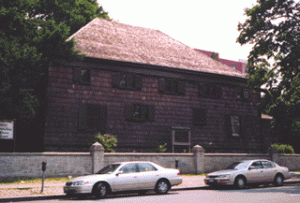Originally named Vlissingen, after a city in the Netherlands, Flushing was occupied by setters who were under a charter with the Dutch West India Company in 1645. After the establishment of this region, a major influx of Quakers from English colonial settlements in Massachusetts took place.
Due to Governor Peter Stuyvesant who banned any practice of religions outside of the Dutch Reformed Church, many citizens, especially Quakers protested against his ban and requested for exceptions for Quaker worship. John Bowne, a English farmer at the time decided to defy Stuyvesant decree and started allowing Quaker meeting and religious practices in his home.

Page of "The Flushing Remonstrnace"
After several attempts of petition and urgings, the Dutch West India Company agreed upon The Flushing Remonstrance, signed on December 27, 1657, which allowed Quakers and other religions to worship and practice freely. The signing of this significant document is claimed to be the precursor of the First Amendment of the Constitution and make Flushing the birthplace of religious freedom in the New World.
After the British gained control of New Amsterdam in 1664, the region was renamed as the Province of New York. Later the region, coined the “Town of Flushing”, was simply renamed as Flushing, although now it refers to a much smaller region.

Map of Flushing, Queens 1891
As time progressed, the building of roads, subway, and bridges between the Flushing region and other boroughs, especially Manhattan, increased the population and economic quality of the region. Initially containing a population of many white English settlers and then Italians and Greeks, the area today is a hub for many Chinese and Korean settlers. Now large enough to rival Manhattans Chinatown, the Flushing territory is a diverse sector with many Chinese, Korean, Japanese, Italians, Greeks and other Asian groups.
There are over a hundred churches in Flushing due to the fact many Asian groups, especially the Chinese and Koreans, are devout worshipers. Immigrating over in large numbers, especially after the Hart-Celler Act was passed in 1965, many Asians headed first to Chinatown in Manhattan and then to Flushing. Another wave of Korean immigration occurred in the late 20th century and early 21st century. Today, Flushing inhibits and displays the mark several different immigrant groups have left in the region. Now regarded as a ethnic cluster of Chinese and Koreans, Flushing Queens is a place anyone can experience some Asian culture.
Landmarks and Historic Places in Flushing:
1.The Quaker Meeting House (137-16 Northern Boulevard)
For over 300 years, this house has been used for religious purposes by the Society of Friends, except during the American Revolution when it was converted into a hospital. This “church” has been one of the most major and renowned religious venue in the region. It is the oldest house of worship in New York. Behind the house is the graveyard of John Bowne and his family, who helped to fight for the free practice of all religions. Some of the visitors to this house include George Washington, John Woolman and William Penn.
2.The Bowne House (37-01 Bowne Street (at Northern Boulevard))
Thought to be the oldest standing house in Queens, this building dates back to 1661 and was built by John Bowne. This house, during the 17th century, held the meetings of many Quakers who meet in secret, defying Peter Stuyvesant law on banning all other religious practices. Today it is preserved for it historic significance and is a lasting mark showing the changes that have occurred since its creation.
3. The Queens Historical Society (143-35 37th Avenue between Bowne Street and Parsons Boulevard
This section encompasses a region with over 300 years of history. Providing tours and events for residents and new comers, one can experience and learn of the vast history of Flushing. One of the most notable features is the location of this society, the Weeping Beech Park, named as such because the park’s tree was grown from a shoot imported from Belgium in 1847. In addition, exhibitions also contain remnants of a Victorian past with lacework, notebooks, eyeglasses and diaries. To learn more or book tours and attend events, visit their website at http:// www.queenshistoricalsociety.org/co2llections.html.
4. St. George’s Episcopal Church (on Main Street between 38th and 39th Avenues)
Originally built in 1761 in downtown Flushing, today it is the third building in the same place dating back to 1854. The church has served a changing congregation for over 300 years. Serving various people from over twenty different nations of origin, this Church has been a major source and place of strength for hundred in the area. Having been maintained over the years, especially due to recent natural decay, this church illustrates the connection and unity between the people in the region of Flushing. A important fact of this church is that Francis Lewis, a Founding Father and signer of the Declaration of Independence, from 1765 to 1790 was the warden of this church.







